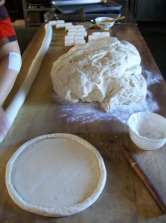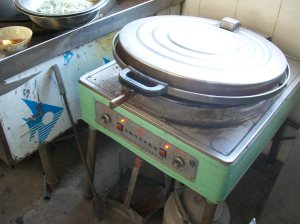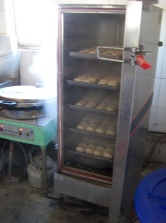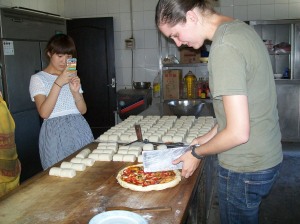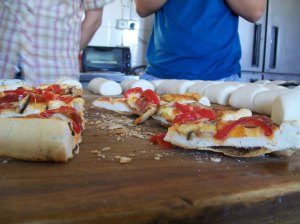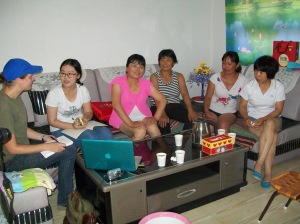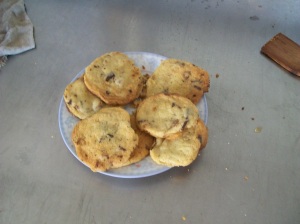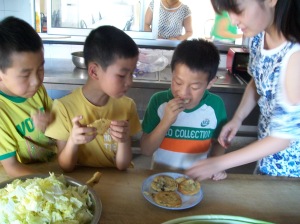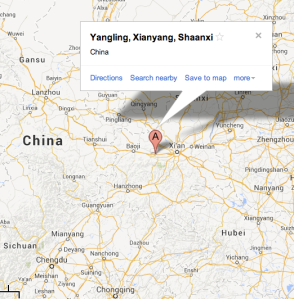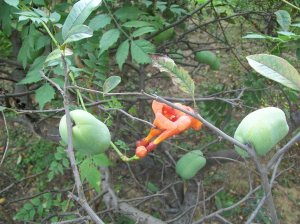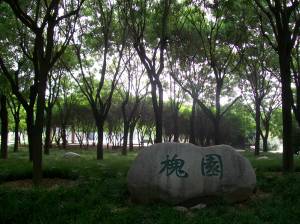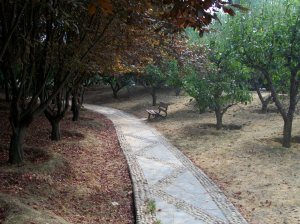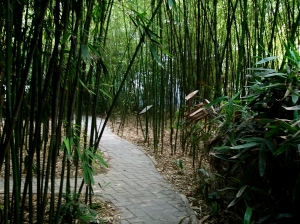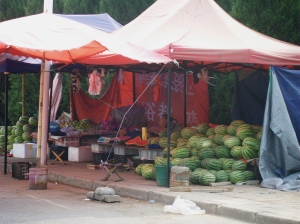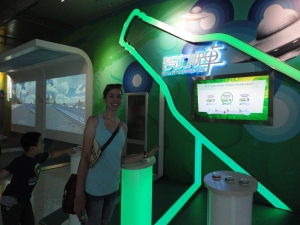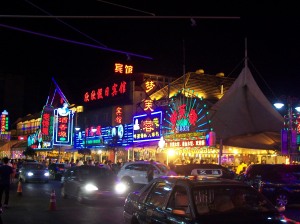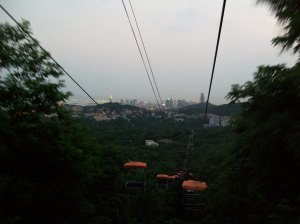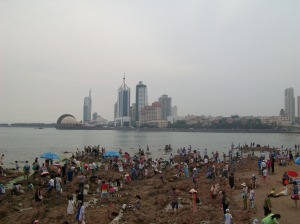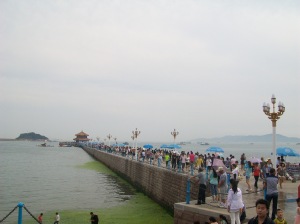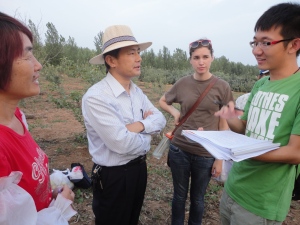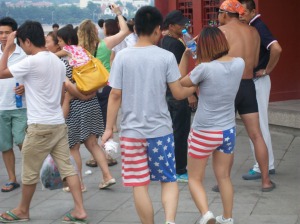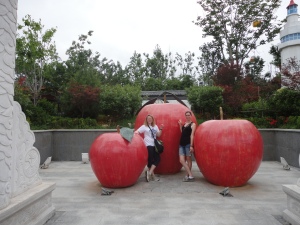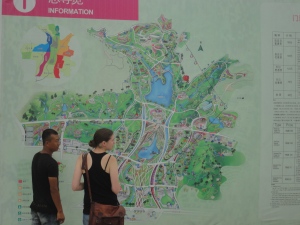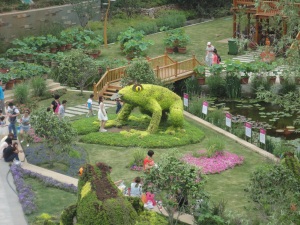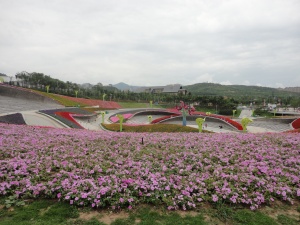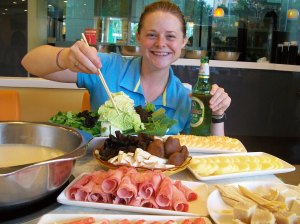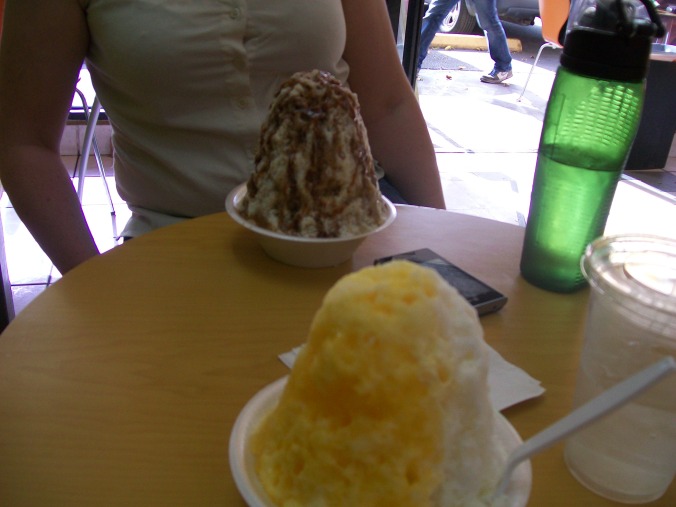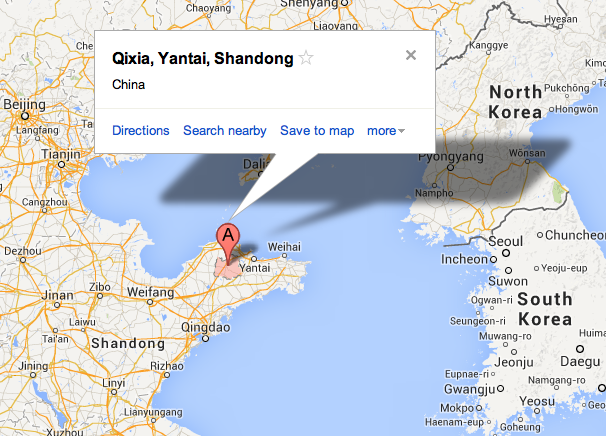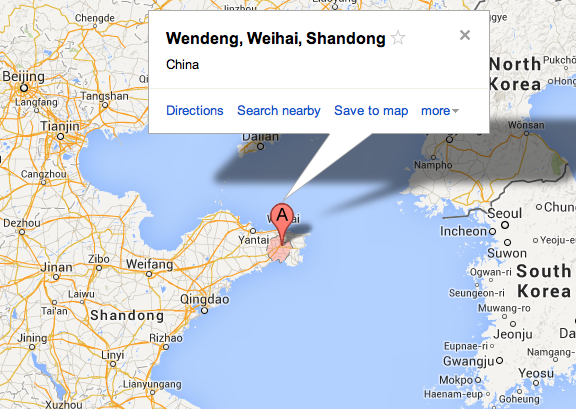Monday the 21st was our first full day in Baishui, and straight after breakfast we (Prof. Li, some students, Julia, & I) piled into a van and drove into town to visit the county apple bureau. There we had a long meeting with an extension agent/administrator who was very helpful and gave us a lot of information about apple production and cooperatives in Baishui county, including two books on those topics (one in English and one in Chinese – both with lots of pictures). Much like Prof. Li, he was eager to help us and answer our questions. Best of all, everyone was very encouraging about both our survey and photovoice projects. We also met a woman who worked at the bureau, Jinhua, who would be helping arrange our village visits.
Julia and I were hanging out in our room at the apple station after lunch, when we were visited by two girls who lived next door. They were cousins spending the summer at the apple station while they took driving lessons in town (the mother of one works at the apple station). We chatted a little, and when they found out I like to cook they wondered if I could teach them how to make some American foods, like pizza and cookies. UM, CAN I?!?! Obviously, I was delighted and began plotting immediately. More on that later.
In the afternoon we loaded up the van again, this time with three graduate students (Pengjuan, Qiuming, and Yanjing), and picked up Jinhua from the apple bureau. She took us to a nearby village and introduced us to the president of their apple cooperative. The two of them arranged for women apple farmers to come talk to us, and as they arrived I could barely contain my excitement. Based on my previous experiences in Shandong, I was expecting them to say, “Actually, never mind, no thanks,” and leave at any moment. But the atmosphere was completely different. Everyone was very relaxed, hanging out in the home of the cooperative president, and we were introduced to the women by two people they knew (the co-op president and Jinhua). Much better than just approaching people cold as strangers.
I don’t think I mentioned on this blog that a few days before leaving Shandong, I was able to hold a 90-minute focus group with some women peach farmers who were very friendly and willing to answer my questions. Plus it gave me a chance to try out the questions I’d had translated, and see where those conversations led. These were questions like: “What kinds of work do you do in the orchard? How long do you spend cooking every day? What do you do in your free time? How often do you talk to other women farmers? Who drives your household’s vehicles? Who manages your household finances? Whose name is on the lease for your land?”
Of course, the answers are always fascinating. I’m hesitant to post too much of the results here while we’re still in the midst of our research. Maybe I can publish a summary here when I’ve had a chance to sit down and analyze it all. One thing I can share is that at the end of our focus group questions (which lasted about an hour) I asked if the women had any questions for Julia and me, about us or America, and they absolutely did. They wanted to know what the typical age is for getting married in America (obviously pretty old, based on Julia & me…), who cares for the kids (fascinated to learn about stay-at-home dads), who pays for weddings, and who cares for the elderly. For all these questions, we gave our best representation of the various options available in America, and where traditions are changing. The women also commented that they had seen on TV that there is much broad, open space in America, while China is very crowded. We agreed that in this instance the TV portrayal was actually pretty accurate. Then again, few places are as crowded as China.
The moment of truth came when I brought out the cameras and asked if they’d take photographs to help us better understand some of the topics we had discussed in our conversation, and they all agreed! I was ecstatic. They wound up taking only one camera, saying that the rest of them could just take pictures with their cell phones. We arranged to meet up again three days later to discuss their photographs. It all happened so smoothly that I was afraid I’d jinx it somehow, and tried not to get my hopes up.
We returned to the apple station around 7:00. During our morning meeting, Prof. Li had suggested that we give a presentation to the students at the apple station, talking about what it’s like to attend college in the US. During supper, Prof. Li informed us that we should give our presentation that evening, so Julia & I ate quickly rushed back to our room to put the finishing touches on the powerpoint we’d started earlier in the day. The presentation itself was pretty easy to give – Julia and I have a lot we can say about our college experience. And the audience was about 15 students our age, so it wasn’t terribly formal. We talked about the differences between admissions in the US and China, the different kinds of colleges/universities in the US, what we studied, what we liked best about our schools, and how we paid for it. At the end we had some extra time, so we pulled up the internet and showed them more pictures of our schools. They had asked us to talk about American culture in general, so we were also trying to tease out what aspect of American culture they’d like to talk about, and we landed on food (surprise, surprise). So that led us down a long rabbit hole that primarily featured foods-Julia & I-miss-du-jour. People seemed to enjoy it well enough, because they requested to have “English Corner” again the next night. So we prepped a presentation on “Summer in the US” for Tuesday night and “Agriculture/Farming in the US” for Wednesday.
Over the next two days we left the apple station each day to visit nearby villages and conduct surveys. The architecture of the houses in this area (the Loess Plateau of Shaanxi) are really interesting. Traditionally homes were built into caves in the hillsides, and even though all the homes we’ve visited are free-standing, they still have the same design of long, domed rooms built side-by-side. They’re not technically underground, I guess, but they are insulated on all sides except the front doorway by a thick layer of earth (see pics from Huangling) that keeps the rooms quite cool (and presumably cozily warm in the winter).
On Thursday morning Julia went out with a couple students to collect more surveys while I stayed at the apple station to do some cooking with Jiaying and her cousin. We decided to start with pizza. Jiaying had assured me we could use the station’s kitchen, and some of the ingredients they had in stock (we’d gone a grocery run for everything else we needed the day before). I should explain that there’s a single kitchen & dining hall that feeds all the staff, students, and visitors and the apple station. Julia said it reminded her of camp, and I agree. The kitchen staff was really sweet and friendly, and there were a couple families with small children staying at the station, so mealtimes did have a bit of that homey, communal feel of camp.
Anyway, we went to the kitchen and first asked for some yeast to start the pizza dough, only to find out that it was mantou-making day, and all the yeast was used up. So we improvised, and decided to use some of the mantou dough as our pizza crust. In fact, the big blob of white dough on the counter reminded me of the batches of pizza dough I’d help make in the Grinnell bakery, quantity-wise at least.
We grabbed a big hunk of dough and rolled it out, and spooned some pizza sauce on top. I’d thought we’d have to make our own tomato sauce, but Jiaying had already bought some – apparently she’s been ordering ingredients like pizza sauce, mozzarella, and butter online for awhile now with the hope of learning to make some interesting foreign foods. The pizza sauce turned out to be a little thin and sweet for my taste (I could have probably made a more typically American sauce from scratch) but she was super excited about using it. We chopped up some red bell peppers and mushrooms (which we managed to brown in the kitchen’s enormous wok) and threw them on the pizza with the mozzarella and slices of Chinese sausage (think pepperoni, but slightly sweet and not spicy at al). All chopping was done with a enormous Chinese cleaver, of course.
The tricky part was figuring out how to bake it – ovens are pretty rare in China. Jiaying had rustled up a small toaster oven that we were planning to use for our cookie experiment later, but for the pizza we decided to be adventurous and try cooking it on the press used to make bingzi (Chinese pancakes, basically – the egg & scallion ones are probably most well-known in the US). And it actually worked pretty well, provided we wedged a spatula under the lid so the cheese wouldn’t stick to the top, making the crust nice and crispy on the bottom.
The flavor of the crust wasn’t exaaactly right – probably because it was meant to be soft, fluffy mantou, not dense chewy pizza crust. But close enough, I say! Certainly better than what passes for pizza at Pizza Huts here. There was just enough for everyone in the kitchen to get a slice, and people seemed to like it. (Which was good, because I felt bad for getting in their way while they were trying to make lunch for everyone.
In the afternoon we returned to the village where I’d done a focus group on Monday, to see if the women had taken any pictures. I was a little anxious about it – What if it turned out to be awkward and weird? What if no one had taken photos? Or no one showed up at all? But it was wonderful! We were in the same room where we’d had the focus group on Monday, and we didn’t have to wait too long for the women to turn up. It turned out that the women who’d said they’d use their cell phones had sort of forgotten about it, but the woman who’d taken the camera had taken over 100 photos! And it looked like she’d shared the camera with some of the other women, so she wasn’t the only one taking pictures, and they captured aspects of their lives I’d never have been able to take pictures of on my own. Sorry for all the gushing and no examples, but for ethics and privacy reasons I can’t post the pictures on the internet. I can, however, share them with you in person once I’m stateside. :)
We sat together discussing the photographs for nearly 2 hours. I hadn’t meant for the focus group to last that long, but the women seemed to be enjoying themselves, and I was reluctant to bring our discussion to a halt. Julia was kind enough to let us videotape the entire conversation on her camera, so we have a recording of that as well. Jiaying had tagged along with us, and assumed the role of videographer.
When we returned to the apple station we got supper and then headed to the kitchen to bake chocolate chip cookies. I was totally winging it recipe-wise – How many tablespoons in this block of butter? Who knows! My water bottle has markings for fluid ounces, so I poured water from bowls into my water bottle to estimate volume measurements. (Measuring cups are not a mainstay in Chinese kitchens). Miraculously, the cookies actually came out pretty well! My kitchen helpers were kind of shocked by how much butter and sugar is in the recipe, and I can’t really blame them. It was also very helpful that we had a fridge, so we could chill the dough a little bit before working with it. (This was the major obstacle to making cookies in Lesotho. The only time we had a fridge was when room temperature = fridge temperature.)
We baked the cookies in the little toaster oven on a tiny tray that fit just five cookies at a time. But that was okay because it didn’t have any temperature options – just top burner, bottom burner, or both burners, so it took a few tries to work out a combination that produced cookies that weren’t too toasty on the top or bottom. (For the record: preheat both burners & bake for one minute, then bottom only for 4 minutes, top only for 6 minutes, then turn off heat & leave cookies in oven for 2 minutes.) But even the rejects were edible, so everyone was happy.
Due to the small batch size we didn’t finish baking all the dough off that night. So we had a second cookie party Saturday afternoon, when we were joined by a few of the little boys running around the station. And seeing them all descend on a plate of cookies was just about the most precious thing I’ve ever seen in my life. They were definitely fans, and got the full, fresh-out-of-the-oven-melted-chocolate experience.
We collected more surveys on Friday and Saturday – about 100 total! – and then returned to Yangling on Sunday. Our week in Baishui was absolutely a highlight of our summer in China, not only because it was so productive research-wise, but the people at the apple station made us feel so at home. I was truly sorry to leave – I could picture spending a whole summer there, hopping around between villages and conducting more kitchen experiments. But we had to be off to explore new places. Our second Shaanxi destination was Huangling, which we just left yesterday, and I’ll write all about our experiences there in my next post.
Stray Thoughts
- At the apple station the kitchen always made perfect mantou – big, hearty, and kept warm in the steamer cabinet. I got in the habit of eating one or two mantou at breakfast split open and stuffed with lots of chopped green (hot) peppers and a little bit of chopped scallion. Whether this is a Shaanxi thing or not I can’t say, but people in Baishui definitely like it. And like all great breakfast foods, after a couple days I felt like I’d been eating mantou with hot peppers every morning my whole life.
- The one downside to Baishui was the prosperous mosquito population. Despite the fact that we never opened the windows and kept the door closed as much as possible, they somehow found a way to infiltrate our room. Mosquitoes don’t usually bother me that much, but these were different. One morning I woke up with two bites on my eyelid, and after that I became fairly aggressive about going on a mosquito killing spree each night before I went to bed.
